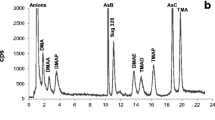Abstract
Cation exchange and anion exchange liquid chromatography were coupled to an ICP-MS and optimised for the separation of 13 different arsenic species in body fluids (arsenite, arsenate, dimethylarsinic acid (DMAA), monomethylarsonic acid (MMAA), trimethylarsine oxide (TMAO), tetramethylarsonium ion (TMA), arsenobetaine (AsB), arsenocholine (AsC), dimethylarsinoyl ethanol (DMAE) and four common dimethylarsinoylribosides (arsenosugars). The arsenic species were determined in seaweed extracts and in the urine and blood serum of seaweed-eating sheep from Northern Scotland. The sheep eat 2–4 kg of seaweed daily which is washed ashore on the most northern Island of Orkney. The urine, blood and wool of 20 North Ronaldsay sheep and kidney, liver and muscle from 11 sheep were sampled and analysed for their arsenic species. In addition five Dorset Finn sheep, which lived entirely on grass, were used as a control group. The sheep have a body burden of approximately 45–90 mg arsenic daily. Since the metabolism of arsenic species varies with the arsenite and arsenate being the most toxic, and organoarsenic compounds such as arsenobetaine the least toxic compounds, the determination of the arsenic species in the diet and their body fluids are important. The major arsenic species in their diet are arsenoribosides. The major metabolite excreted into urine and blood is DMAA (95 ± 4.1%) with minor amounts of MMAA, riboside X, TMA and an unidentified species. The occurrence of MMAA is assumed to be a precursor of the exposure to inorganic arsenic, since demethylation of dimethylated or trimethylated organoarsenic compounds is not known (max. MMAA concentration 259 μg/L). The concentrations in the urine (3179 ± 2667 μg/L) and blood (44 ± 19 μg/kg) are at least two orders of magnitude higher than the level of arsenic in the urine of the control sheep or literature levels of blood for the unexposed sheep. The tissue samples (liver: 292 ± 99 μg/kg, kidney: 565 ± 193 μg/kg, muscle: 680 ± 224 μg/kg) and wool samples (10 470 ± 5690 μg/kg) show elevated levels which are also 100 times higher than the levels for the unexposed sheep.
Similar content being viewed by others
Author information
Authors and Affiliations
Additional information
Received: 29 February 2000 / Revised: 26 April 2000 / Accepted: 1 May 2000
Rights and permissions
About this article
Cite this article
Feldmann, J., John, K. & Pengprecha, P. Arsenic metabolism in seaweed-eating sheep from Northern Scotland. Fresenius J Anal Chem 368, 116–121 (2000). https://doi.org/10.1007/s002160000482
Issue Date:
DOI: https://doi.org/10.1007/s002160000482




